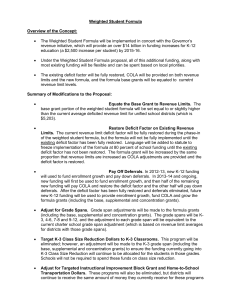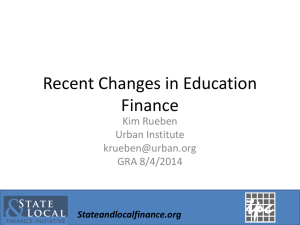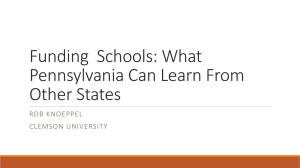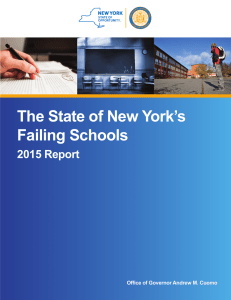Weighted Pupil Funding Formula
advertisement
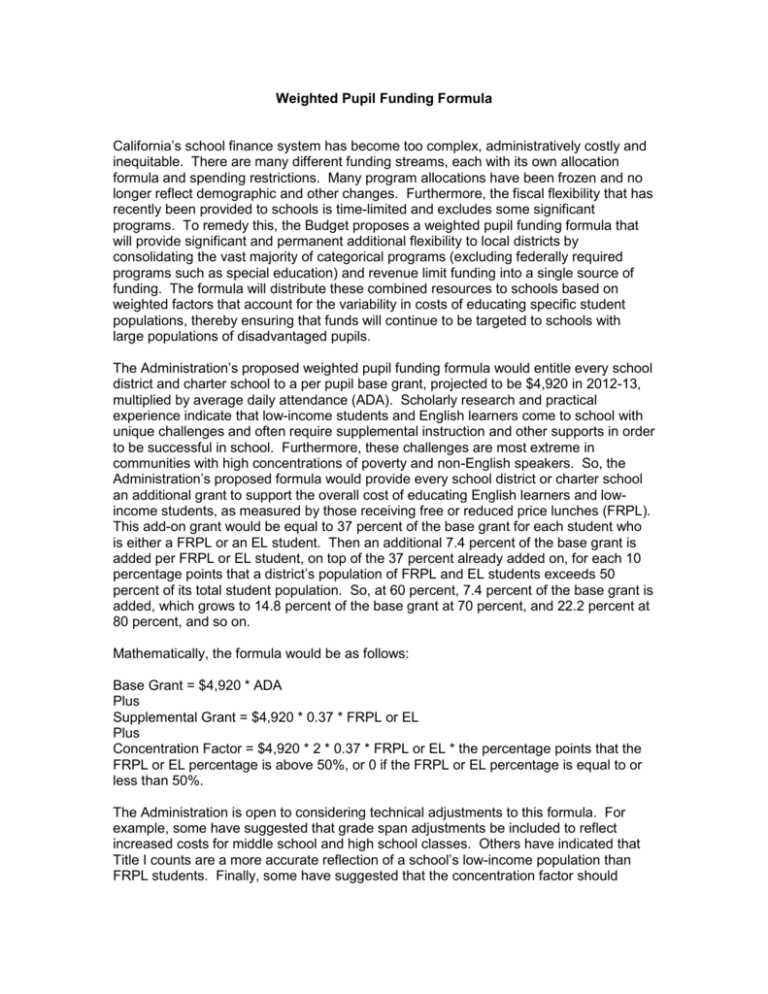
Weighted Pupil Funding Formula California’s school finance system has become too complex, administratively costly and inequitable. There are many different funding streams, each with its own allocation formula and spending restrictions. Many program allocations have been frozen and no longer reflect demographic and other changes. Furthermore, the fiscal flexibility that has recently been provided to schools is time-limited and excludes some significant programs. To remedy this, the Budget proposes a weighted pupil funding formula that will provide significant and permanent additional flexibility to local districts by consolidating the vast majority of categorical programs (excluding federally required programs such as special education) and revenue limit funding into a single source of funding. The formula will distribute these combined resources to schools based on weighted factors that account for the variability in costs of educating specific student populations, thereby ensuring that funds will continue to be targeted to schools with large populations of disadvantaged pupils. The Administration’s proposed weighted pupil funding formula would entitle every school district and charter school to a per pupil base grant, projected to be $4,920 in 2012-13, multiplied by average daily attendance (ADA). Scholarly research and practical experience indicate that low-income students and English learners come to school with unique challenges and often require supplemental instruction and other supports in order to be successful in school. Furthermore, these challenges are most extreme in communities with high concentrations of poverty and non-English speakers. So, the Administration’s proposed formula would provide every school district or charter school an additional grant to support the overall cost of educating English learners and lowincome students, as measured by those receiving free or reduced price lunches (FRPL). This add-on grant would be equal to 37 percent of the base grant for each student who is either a FRPL or an EL student. Then an additional 7.4 percent of the base grant is added per FRPL or EL student, on top of the 37 percent already added on, for each 10 percentage points that a district’s population of FRPL and EL students exceeds 50 percent of its total student population. So, at 60 percent, 7.4 percent of the base grant is added, which grows to 14.8 percent of the base grant at 70 percent, and 22.2 percent at 80 percent, and so on. Mathematically, the formula would be as follows: Base Grant = $4,920 * ADA Plus Supplemental Grant = $4,920 * 0.37 * FRPL or EL Plus Concentration Factor = $4,920 * 2 * 0.37 * FRPL or EL * the percentage points that the FRPL or EL percentage is above 50%, or 0 if the FRPL or EL percentage is equal to or less than 50%. The Administration is open to considering technical adjustments to this formula. For example, some have suggested that grade span adjustments be included to reflect increased costs for middle school and high school classes. Others have indicated that Title I counts are a more accurate reflection of a school’s low-income population than FRPL students. Finally, some have suggested that the concentration factor should increase more gradually as the proportion of a school district’s population which is lowincome or an English learner increases. The Administration proposes a 6-year phase-in with 5 percent of total school funding allocated based on this formula in 2012-13, growing to 15 percent in 2013-14, 40 percent in 2014-15, and by an additional 20 percent each year thereafter until completely implemented in 2017-18. For 2012-13 only, districts will continue to receive an allocation equivalent to the amount they received for the Home-to-School Transportation program in 2011-12 on top of the amounts provided through the formula. Also, for 2012-13 only, no district will receive less than it received on a per pupil basis from the programs included in the formula and Home-to-School Transportation in 201112. All funding not allocated based on the formula will be allocated in proportion to the amount each school district received on a per unit of average daily attendance 2011-12. However, all of the programs that will be replaced by the formula will immediately be made completely flexible for use in supporting any locally determined educational purpose. This includes K-3 Class Size Reduction and Economic Impact Aid, which are not included in the current flexibility. Under the Administration’s proposed formula, most large urban school districts that serve low-income communities will receive additional funding. None of these schools will receive less funding. Furthermore, any reduction in funding that a school district receives caused by the formula will be mitigated by the hold harmless for 2012-13, the six-year phase in and the billions of dollars in projected Proposition 98 growth funding that will be provided to schools over the next few years. This proposal will be coupled with a system of accountability measures that will be the basis for evaluating and rewarding school performance under this finance model. These measures will include the current quantitative, test-based accountability measures, along with locally developed assessments and qualitative measures of schools. Beginning in 2013-14, incentive funding equal to 2.5 percent of the base grant will be provided to school districts and charter schools which meet accountability metrics established by the State Board of Education. Current program funding that would be included in the weighted formula and fully flexed are: Apprentice Programs Summer School Programs ROC/Ps Grade 7-12 Counseling Foster Youth Programs (excluding county grants) Specialized Secondary Program Grants Gifted and Talented Economic Impact Aid Prof. Development Institutes for Math and English Principal Training Adult Education Adults in Correctional Facilities Partnership Academies Agricultural Vocational Education Educational Technology Deferred Maintenance Instructional Materials Block Grant Staff Development National Board Certification California School Age Families Ed. Program California High School Exit Exam Civic Education Teacher Dismissal Apportionments Charter Schools Block Grant Charter EIA Community Based English Tutoring School Safety Block Grant High School Class Size Reduction K-3 CSR Advanced Placement Grant Programs Student Leadership/CA Assoc. of Student Councils Pupil Retention Block Grant Teacher Credentialing Block Grant Professional Development Block Grant Targeted Instructional Improvement Block Grant School and Library Improvement Block Grant School Safety Competitive Grant Physical Education Block Grant Arts and Music Block Grant Certificated Staff Mentoring Oral Health Assessments Alternative Credentialing District and COE Revenue Limits Property Tax Revenue The only major programs excluded are as follows: Special Education, because of federal program requirements and maintenance of effort issues. School Nutrition (funding for school lunches), because of federal accounting and maintenance of effort issues. After-school Programs, because Proposition 49 requires a ballot initiative approved by the voters to make any changes to afterschool funding. Quality Education Investment Act (QEIA), because this is part of a legal settlement. Pre-school, because it is not a K-12 program. Necessary Small Schools, because this funding is necessary to maintain schools in sparsely populated areas.
